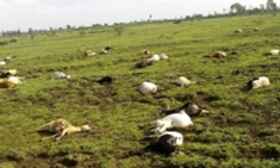Case From Kenya: Violent evictions of the Masai in the name of protecting wildlife to support elite tourism
Laikipia County, a few hours’ drive north of Nairobi, Kenya’s capital, is a microcosm of many of these complicated issues. On this one rugged plateau, poor herders, rich landowners, large- and small-scale farmers, commercial cattle ranchers, tour operators, passionate wildlife activists, elephants, lions, hyenas, cows, goats and zebras are all competing for the same space.
Organisation: Bunge Lamwanachi, Anti Eviction Campaign
Presenting: Wilfred Olal Madigo
Location: Laikipia, ancestral land of Samburu and Masai
Evicted: Herders and pastrolists
Number of Evicted: 500
- Women: 40%
- Children: 20%
Attacked and shot dead: 1500 heards of cattle and 50000 goat and sheep and over 50 pastrolists killed.
Organisation Mobilized: They mobilized themselves and called for a press conference
Legal Action: No
The eviction and killing of cattle and pastrolists was against articles 60 and 61 of the Kenya constitution on land usage and ownership.
Laikipia County, a few hours’ drive north of Nairobi, Kenya’s capital, is a microcosm of many of these complicated issues. On this one rugged plateau, poor herders, rich landowners, large- and small-scale farmers, commercial cattle ranchers, tour operators, passionate wildlife activists, elephants, lions, hyenas, cows, goats and zebras are all competing for the same space.
‘’The widely publicized recent invasions of wildlife conservancies in Laikipia County in Kenya have often been framed as conflicts between pastoralist communities and conservationists. However, the conflicts in Laikipia and elsewhere in northern Kenya ought to be looked at as a national security issue exacerbated by historical land injustices and the pursuit of an inappropriate conservation model that relegates the true owners of the resources to the periphery.’’ Gitau Mbaria The Elephant Newsletter.
Individuals and organizations that constitute the country’s conservation fraternity have capitalized on officialdom’s disinterest by experimenting with a conservation model that is harmful to the communities there. With financial support from multilateral and bilateral donors, as well as big-bucks international NGOs, the fraternity has literary taken over and has been running not just conservation, but also security, livestock marketing and conflict resolution in a manner that greatly interferes with the sovereignty of the communities that claim ownership of the land there.
Historical Facts :
In Moving the Maasai: A Colonial Misadventure, Lotte Hughes paints a picture of pastoralist communities disinherited from their land on two different occasions in 1904 and 1911. The British author says that between 1904 and 1905, colonial authorities forcibly moved the Maasai people from their favourite grazing grounds between Naivasha and Nakuru into two reserves in order to make way for white settlement. Laikipia was one of the reserves while the other was in the south, on the border with Tanzania. According to Hughes, this was done following the 1904 Maasai Agreement through which the community was promised that it could keep the reserved areas “so long as the Maasai as a race shall exist.” She writes that the British did not honour their promise but went on to move the Maasai again seven years later “at gunpoint from Laikipia to an extended southern Maasai reserve.” More than 20,000 people and not less than 2.5 million livestock were moved between 1911 and 1913. All this was done mainly to pave way for white settlers, although, as Hughes says, there were other extraneous reasons, including the desire by the colonial administration to concentrate the Maasai in one reserve in order to better rule over them and to impose taxes. Consequently, the Maasai lost between 50% and 70% of the land they occupied before 1904.
Since the second “move” was implemented, the Maasai have maintained that this was not an “agreement” per se as their leaders signed it under heavy duress and coercion. “This effectively rendered the first Agreement void,” writes Hughes. This supports the intermittent claims made by activists from the community that they have a legal claim over the land now occupied by the mainly white ranchers in Laikipia.
The campaign for redress for this historical injustice reached a crescendo in the early 2000s when the community, led by the defunct Osirigi NGO and people like the late Elijah Marima Sempeta, intensified calls for a return of the lost lands. The latter was a young lawyer who travelled to Britain and unearthed documentary evidence ascertaining that the leases given to the white ranchers had come to an end and that time had come for the ownership of the land to revert to the local community. Following a spirited campaign, the matter fizzled out after Sempeta was murdered outside his home in Ngong Town in circumstances that remain unexplained. However, the push appears to have borne fruit when lease periods were lowered from 999 years to 99 years in Kenya’s 2010 constitution.
Laikipia has “profound inequalities” in land ownership, with 40.3% of the land being controlled by 48 individuals. Among the biggest landowners in Laikipia include Gallman, whose Ol Ari Nyiro ranch is said to be 100,000 acres. Other large ranches include the Ol Pejeta ranch (92,000 acres) that was once associated with Saudi billionaire arms dealer Adnan Khashoggi and the Ol Jogi ranch (67,000 acres) owned by the late French billionaire art dealer Daniel Wildenstein . But even with this kind of inequality, it has been apparent that the ranchers cannot countenance the idea of ever giving up the giant parcels of land to the original owners. Some have been offloading the land to other rich people (some of whom are foreigners) while top business and political elites in the country have also increasingly acquired land there.
The Ranches operate under the Nothern Rangeland Trust which a coalition of the Ranch owners operating in Kenya.
Another approach has been to front the sprawling ranches as important wildlife conservation areas. Targeted in this approach is a powerful and moneyed audience in the West that has contributed immensely to support wildlife conservation in cash and kind. Initially, the white ranchers had not taken wildlife conservation as seriously. For a long time, many had taken to large-scale livestock keeping but later realized that they stood to gain much more by converting their properties to either mixed livestock-and-wildlife areas or to exclusive wildlife conservation zones.
Conservation is a noble cause, but like all other sectors, should be properly regulated. Kenya is currently failing to do that.
Current Crisis.
In February 2017 herders moved in to expansive ranches in search of pasture for their cattle since drought was being experienced in most parts of the country, the Owners and the managers of the ranches opposed this move and this led to a violent conflict that led to the killing of Tristan Voorspuy, a former British military officer and shooting of Kuki Gallmann, the Italian-born owner of the Laikipia Nature Conservancy. At 88,000 acres, it is one of Kenya’s biggest pieces of privately owned land.
The British foreign secretary immediately came to the country and urged the president to offer security to the Ranch owners and immediately the Kenya defence forces and the General Service Unit of the Kenya police were deployed in the area leading to massive destruction, by 10th March 2017 the military had killed over 1500 cows, 50000 goats and sheep and about 50 pastrolists . On 12th February the Mp for Samburu arrested and charged with incitement for raising concerns over the killing of The pastrolists and livestock.
During the campaigns for the Presidential elections, The Kenyan president vowed to compensate the herders who had lost their cattle through the military operation but instead the killings continued, more pastoralists have been displaced or have run away from the conflict majority being women and children.
The sticky Issues.
- The government is protecting the white Ranch owners at the expense of the Maasai community.
- Most leases have expired and the land ought to revert back to the Maasai and Samburu communities as community land.
- According to the maasai culture the cattle is the most important and the most sacred things in their lives the shooting and killing of their cattle is like ripping their soul.
- Wildlife conservation is important but not at the expense of human life, human rights and social justice must go hand in hand with the conservation.
The Institutions/Persons responsible for this evictions
All correspondence must be addressed to the Principal Secretary, Ministry of Environment, Natural Resources and Regional Development Authorities
Northern Rangelands Trust
Private Bag
Isiolo 60300, Kenya
Phone - +254 (0) 701 555 000
E-mail - info@nrt-kenya.org
The Principal Secretary
Ministry of Defense
Ulinzi House, Lenana Road
PO Box 40668 – 00100 Nairobi
Telephone No : 2712054
Fax No ; 2722270
Email : publicaffaire@mod.go.ke
The Principal Secretary
Ministry of Environment, Natural Resources and Regional Development Authorities
NHIF Building, 12th Floor
Ragati Road, Upperhill
PO Box 30126-00100
Nairobi
254 20 2730808/9
254 20 2725707
254 20 2725707




